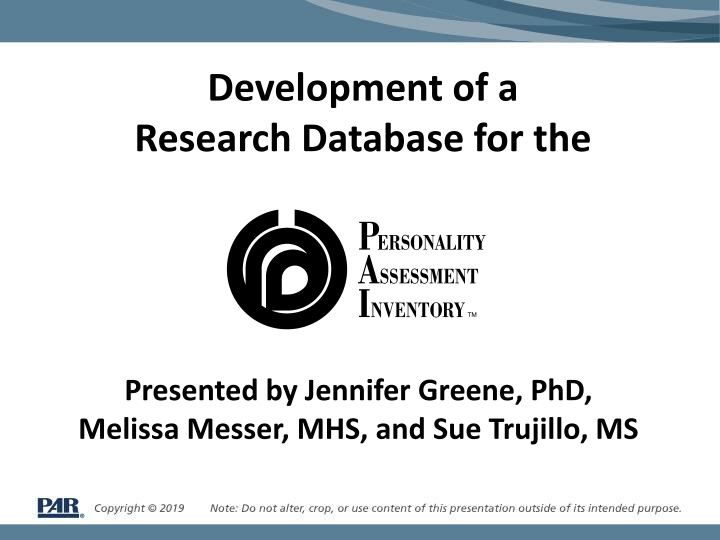
Research Database Development for Personality Assessment Inventory Studies
Explore the utilization of the Personality Assessment Inventory (PAI) in research over the past three decades through the creation of a comprehensive reference list. Methods include coding references into broad categories like personality disorders, psychopathology, and acquired/developmental disorders, yielding insightful results from 1,241 references identified. Cluster analysis further categorizes personality disorders for in-depth examination.
Uploaded on | 1 Views
Download Presentation

Please find below an Image/Link to download the presentation.
The content on the website is provided AS IS for your information and personal use only. It may not be sold, licensed, or shared on other websites without obtaining consent from the author. If you encounter any issues during the download, it is possible that the publisher has removed the file from their server.
You are allowed to download the files provided on this website for personal or commercial use, subject to the condition that they are used lawfully. All files are the property of their respective owners.
The content on the website is provided AS IS for your information and personal use only. It may not be sold, licensed, or shared on other websites without obtaining consent from the author.
E N D
Presentation Transcript
Development of a Research Database for the Presented by Jennifer Greene, PhD, Melissa Messer, MHS, and Sue Trujillo, MS
Personality Assessment Inventory (PAI) The PAI is a self-administered objective measure of adult personality (Morey, 1991) Widely used as a clinical and research tool Consists of 344 items within 22 nonoverlapping scales
Purpose Explore the nature and scope of research that utilized the PAI during the last three decades Describe the creation of a comprehensive list of research references that can be easily accessed by researchers and clinicians
Methods The PAI author identified research studies that were about or used the PAI. These include: Peer-reviewed journal articles, theses, dissertations, and conference presentations References were imported into Mendeley, a reference management software program. Free to use by creating an account at mendeley.com (see handout for instructions)
Methods Coding References were divided into several broad categories: Personality disorders Psychopathology Acquired or developmental disorders Within each broad category, references were tagged by subject using author keywords and relevant terms from the title and abstract For each broad category, the frequency of references was examined
Results 1,241 references were identified Of those, 976 were coded into one or more broad category (n = 333) Personality disorders (n = 333) 9% 34% (n = 556) Psychopathology (n = 556) 57% Acquired/developmental disorders (n = 87) (n = 87)
Cluster A Personality Disorders Odd, eccentric, or bizarre behavior Personality disorders were tagged according to Section II diagnostic codes from the DSM-5. Paranoid, schizotypal, and schizoid personality disorders Cluster B Dramatic, emotional, and/or erratic behavior Cluster C Characterized by anxiety and fearfulness Borderline, antisocial, narcissistic, and histrionic personality disorders Avoidant, dependent, and obsessive compulsive personality disorders
Personality Disorders 4.5% 3.3% (n = 11) Cluster A (n = 11) (n = 307) Cluster B (n = 307) 92.2% Cluster C (n = 15) (n = 15) n = 333 studies
Cluster B 1.0% Borderline Personality Disorder (n = 160) (n = 160) 22.1% Antisocial Personality Disorder (n = 76) (n = 76) 52.1% Psychopathy (n = 68) (n = 68) 24.8% Narcissistic Personality Disorder (n = 3) (n = 3)
Cluster A 9.1% Paranoid Personality Disorder (n = 10) (n = 10) Schizotypal Personality Disorder (n = 1) (n = 1) 90.9%
Cluster C Avoidant Personality Disorder (n = 7) (n = 7) 46.7% 46.7% Dependent Personality Disorder (n = 1) (n = 1) Obsessive-Compulsive Personality Disorder (n = 7) 6.7% (n = 7)
Psychopathology Social Anxiety Panic disorder PTSD Eating disorders Anxiety Depression Internalizing Suicide/suicidal ideation Addiction Aggression Alcohol abuse Substance abuse Mania Gambling disorder Externalizing Grandiosity Paranoia Psychosis Schizophrenia Somatoform disorders Reality- Impairing
Psychopathology 12.1% Internalizing 48.7% Externalizing Reality-Impairing 39.2% n = 556 studies
Internalizing Domain (n = 57) Anxiety (n = 57) 8.5% (n = 94) Depression (n = 94) 21.0% 2.6% (n = 41) Suicide/suicidal ideation (n = 41) 15.5% (n = 7) Social Anxiety (n = 7) Panic disorder (n = 7) (n = 7) 2.6% 15.1% 34.7% PTSD (n = 42) (n = 42) (n = 23) Eating disorders (n = 23)
Externalizing Domain 2.8% 1.8% 1.8% Addiction (n = 4) (n = 4) (n = 103) Aggression (n = 103) 27.1% (n = 42) Alcohol abuse (n = 42) 47.2% Substance abuse (n = 59) (n = 59) (n = 6) Mania (n = 6) 19.3% (n = 4) Gambling disorder (n = 4)
Reality-Impairing Domain 5% Gradiosity (n = 3) (n = 3) 8% 28% (n = 5) Paranoia (n = 5) 10% Psychosis (n = 7) (n = 7) Schizophrenia (n = 33) (n = 33) 49%
Acquired or Developmental Disorders ADHD (n = 22) (n = 22) 19% 25% ASD (n = 2) (n = 2) 2% TBI (n = 47) (n = 47) 54% Concussion (n = 16) (n = 16) n = 87 studies
Limitations List is based on author identification of studies rather than a formal search May not be representative of the total research literature Some categories have small n sizes, which may limit conclusions
Conclusions Use of the PAI reference list may facilitate research in the study of personality disorders, psychopathology, and/or acquired/developmental disorders Additional research could include meta- analytic studies that address specific questions related to these topics






















